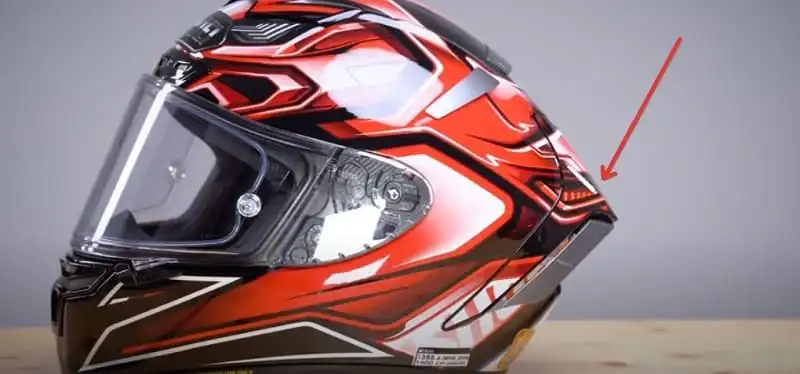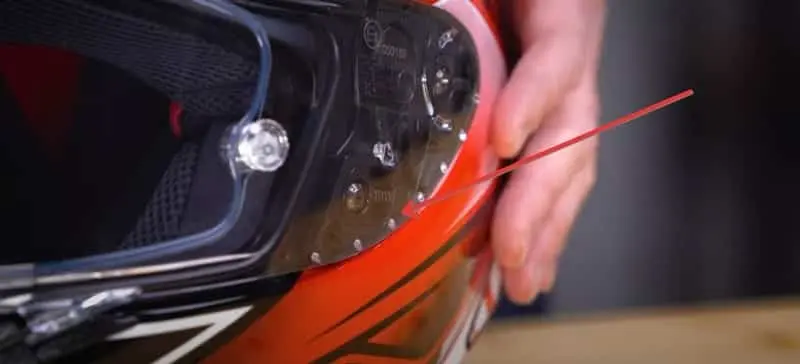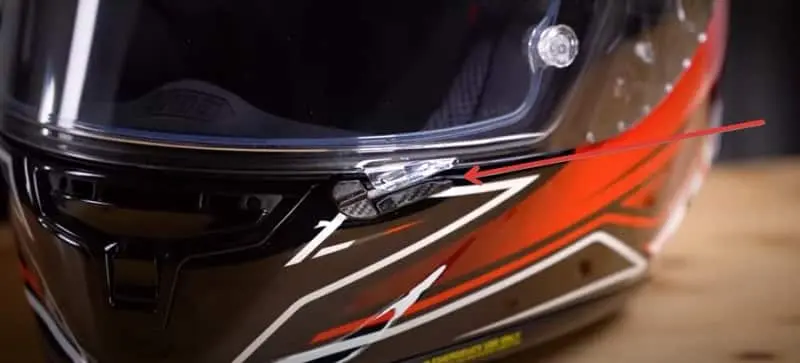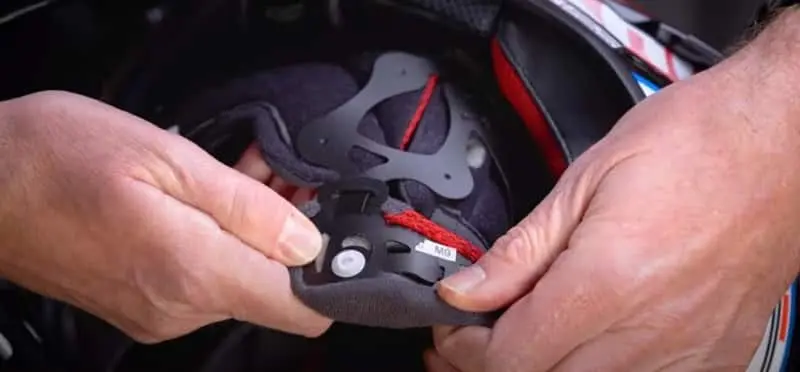If there’s a more popular helmet with our customers than this Shoei X-Spirit 3 race helmet, I’ve yet to discover it. So stick around, and I’ll run through the basics that make this helmet so well-loved by the people who, in all fairness, have spent a big old wedge of their money on one.
It’s Shoei’s top-of-the-range race helmet, and it’s been around for going on six years as we write this review. But, even though it’s been around for such a long time, I’d say this lid represents the pinnacle of sports helmet design.
Shoei X-Spirit 3 Review
Table of Contents
Shell Construction
The shell is made from Shoei’s advanced integrated matrix plus. That’s a composite of fibers inside Shoei’s own resin that they’ve developed to help manage impacts better and also to keep the overall weight down.
Putting this lid on our scales shows the work Shoei has paid off in terms of weight. A size medium weighs 1407 grams, making it one of the lighter helmets we’ve weighed.
Ventilation
This helmet has four main air inlets to keep the rider cool on the inside. Two on the chin bar and two up top. The upper of the two chin vents are fairly conventional.
You slide the slider (located on the front of the chin bar) down, exposing an inlet that draws air inside and then channels it out through the top of the chin bar.
The lower of those two vents is also a slider, but it’s a bit more innovative. The air through the vent can travel sideways through the chin bar, passing through outlets behind the cheek pads.
This cools those cheek pads down and reduces the temperature on the side of the rider’s face.
The two vents on top are a kind of dual-action. Sliding the shutters open allows air to flow to the inside of the lid, where it can circulate through channels in the EPS impact liner and escape through the exhaust vents at the back.
These exhaust vents are always open, pulling warm air through the helmet and letting it escape from the outside.
When I said these vents are dual-action, the air coming through these vents doesn’t only travel directly through to your skin on the inside.
Shoei says that the direct flow of air does cool you down a bit, and it’s also reassuring to feel it as it hits your skin, but they also say the cooling effect of that is limited.
When a lid fits tightly, Shoei says that makes it harder for air to circulate through those channels in the EPS, making the polystyrene impact liner of the EPS heat up.
Shoei’s solution is to direct some of the incoming air through the vents to travel through channels between the shell and the EPS impact liner.
They say that cools down the EPS and reduces the overall temperature inside the helmet.
One of the big benefits of Shoei over other manufacturers is that they’ve got their wind tunnel which lets them test things like the ventilation and aerodynamics.
Aerodynamics
Aerodynamics is key with a racing helmet because speed stability is crucial.
Shoei has some impressive stats on the X-Spirit 3 compared to the X-Spirit two. They say there’s three percent less lift and ten percent less drag, and yawing action is reduced by half compared to the predecessor.
One of the main plus points from the customer reviews for this helmet is that it holds steady in the wind flow.
Some of that aero improvement comes from the add-on spoilers located at the rear of the helmet. They help get the air off the shell without disrupting the lid’s performance.

The two lower spoilers are designed to optimize stability in a straight line. The potential downside is that it can make it harder to turn your head at speed.
However, those spoilers are removable, and smaller versions are available as options that make the helmet more suited to when the rider has their head turned to one side.
Shoei’s UK race service, the people who look after the British Super Bikes racers in the UK, tell us hardly anyone ever swaps those spoilers, but the option is there.
Visor
Small protrusions located on the side of the visor are called vortex generators. The idea is that they kick wind away from the visor surface to reduce the effect of the noise.

The visor itself is quick release, and it takes seconds to swap. It lifts and lowers with the tab on the left-hand side and clicks firmly down on the final push.
There’s an additional sliding lock to make sure it stays down. Slide the tab up, and then the visor’s held in place. So it’s not coming undone accidentally.

There’s another use for this tab. If you start with the visor up and then pull this tab up before you lower the visor, pushing the tab keeps that visor open slightly.
It’s a guide keeping a small gap around the base just for some airflow.
And then, if you push through that little bit further, the visor sits down normally. So it’s not locked down; it’s as if it would have been normally pushed down.
That tab leads to one of the few criticisms of this helmet from the people who bought one. Some say it’s a little bit too easy to accidentally lift that tab and lock the visor down when you didn’t want it locked down.
My advice is to practice using that lock a few times, so if you ever find the visor is reluctant to lift, you’ll know why and know what to do to sort it out.
The visor has tear-off posts so racers can put a film across the front that they tear away to instantly get rid of dead bugs in front of their view.
Because the visor is perfectly flat from top to bottom, those tear-offs will sit neatly on the visor without any air bubbles forming between the tear-off and the visor.
Anti Fogging
There’s a pinlock insert to protect against the mist. It’s a max vision insert to cover all of the eye ports.
The insert is called a pinlock Evo, a Shoei-specific name for what everyone else calls a Pin-Lock 120. It’s the most missed retardant pin lock option that’s available.
Interior
The liner is fully removable, as you’d expect from a race helmet like this. It’s got thinner sections that tally with the vent inlets, allowing air to flow more freely through that comfort liner.
The cheek pads have channels that are designed to accommodate spectacle arms. The lining is also customizable in terms of its fit.
Different thicknesses of skull and cheek pads are available, and optional pads attach around the temples.
This means you can slightly alter the shape of the interior to suit your head shape. There’s also a quick way of altering the lining to suit different riding positions.
In standard position, the X-Spirit 3 sits fairly straight on the rider’s head, which suits riding in all but the most extreme tucks, which are the things you’d get when riding on a track.
On track days, you can put this helmet in what’s known as race mode, which will tilt the helmet back slightly and give you more forward vision when your head is angled down.
It’s dead simple to switch it. First, you apply downward pressure on the front top of the cheek pads, making them slide down inside the helmet.
You then unclip the rear popper on the skull pad, slide it out, and then there’s a little change you’re making there to alter the angle of the skull pad.

The recesses behind the comfort liner let you fit intercom speakers without upsetting the riding comfort.
However, foam inserts clipped into those recesses in standard trim, so if you’re going without comms, you’ve got those in there to deaden the sound a bit.
There’s a light chin curtain supplied in the box that you can slot around the chin to protect against draughts.
Alternatively, a more solid wind deflector can also slot into place to kick a bit of the wind away from the chin.
The final but crucial detail with the interior is the strap fastener. As you would expect from a race helmet, it’s a D-ring setup, but I find it’s always best to make these things clear.
The covers that stop this strap from rubbing against your skin are removable, so they can be taken out for washing.
Shell Sizes
The last pieces of info before I wrap up are sizing and approvals. The X-Spirit 3 comes in sizes extra small to double XL.
There are four shell sizes, extra small and small. Helmets share the smallest shells, medium and large each has their shell, and then XL and 2XL share the largest of those shells.
Safety Certification
Terms of approvals, it’s ECE 2205 for the road. It’s ACU gold for racing in Britain and achieved the maximum five stars in the UK government’s sharp impact testing program.
At the beginning of this article, I said this was possibly the most popular helmet with users. I’m basing that on the reviews left by owners.
Of the 85 posted for this helmet as we write this review, only one reviewer gave four stars, and the rest gave the full five stars out of five.
Quite a few people amongst those reviewers call this helmet noisy, but most people still give it five stars.
Some people say it’s drafty because of the airflow that comes through, but again, the vast majority still give it five stars.
Shoei has done its best to reduce noise, but race helmets tend to be a bit noisier than regular road lids.
These are the issues that come with using a race helmet on the road.
Another thing is that you don’t get the benefit of an internal sun visor, so you need to swap visors on days when you need a tinted one.
That means extra cost and around $90 for a tinted visor. You might want an extra pin lock, so you don’t have to swap the pin lock from your clear visor to your dark one.
Or you could go for the ultimate and spend around $v260/£190 on a lovely light-reactive visor that will automatically darken or lighten to suit the conditions.
So I’ve worn both the original x spirit and the expert 2 in the past.
I smashed the screen and clocks on my race bike by headbutting them with an Experian a few years ago, and this helmet has also been brilliant in my time with it.
If I ever have a late-life crisis and decide that I want to go racing again, which I won’t, there are only two or three helmets that I’d consider wearing, and this is on the top of that list.
In Conclusion
The Shoei X-Spirit 3 motorcycle helmet provides superior protection for the rider’s head, face, and neck.
The six-layer AIM+ shell construction provides maximum protection for the wearer, while the double-density EPS liner and multiple density EPS liners provide high comfort and durability.
The fully removable, washable interior and multiple intakes and extract vents ensure a comfortable fit.
The emergency quick release system allows the rider to remove the helmet within 2 seconds in the event of an accident.
The Shoei X-Spirit 3 motorcycle helmet also features a spoiler and turbulator system to improve the rider’s aerodynamic efficiency.
The Shoei X-Spirit 3 motorcycle helmet also comes with a pinlock-ready visor and is available in four shell sizes.
Where To Buy
| Model | Sports Bike Shop |
|---|---|
| Shoei X-Spirit 3 | From £489 |


